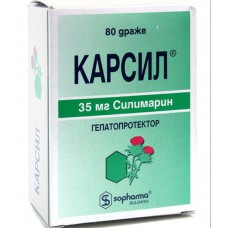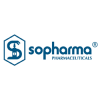Expiration date: 01/2026
Composition and form of release:
Dragees. 1 dragee contains:
milk Thistle spotted fruit extract dry (silymarin equivalent) 35 mg
excipients:
lactose monohydrate wheat starch povidone (Colidone 25) MCC magnesium stearate talc dextrose monohydrate sodium sorbitol bicarbonate
shell excipients:
cellacephate diethylphthalate acacia sucrose gum gelatin titanium talc macrogol dioxide (PEG 6000) brown Opalux paint (sucrose, iron oxide red, iron oxide black, methyl and propylparahydroxybenzoate, purified water) glycerol
Dosage and administration:
Inside, before eating, with a sufficient amount of water. Duration of treatment - at least 3 months.
Adults and children over 12 years of age: treatment of severe liver damage begins with a daily dose of 420 mg (4 tablets 3 times a day). For lighter cases and as maintenance therapy-1-2 tablets 3 times a day.
Prophylactically take 2-3 pills a day.
Clinical and pharmacological group
- Hepatoprotectors
- Pharmacological action
- Hepatoprotective
Description of pharmacological action
Milk Thistle spotted (sharp-edged), Silybum marianum L.-herbaceous plant of the family of compound flowers (Asteraceae). As a medicinal raw material, Mature fruits are used — Fructus Silybi mariani. The fruit contains a group of flavonoid compounds, designated as silimarin (Silimari). Three separate isomeric compounds - silibinin, silidianin and siliristin-have a phenylchromanone structure and have a hepatoprotective effect to a greater or lesser extent.
It interacts with free radicals in the liver and reduces their toxicity. Interrupting the process of lipid peroxidation, it prevents further destruction of cellular structures. In damaged hepatocytes, it stimulates the synthesis of structural and functional proteins and phospholipids (due to specific stimulation of RNA polymerase A), stabilizes cell membranes, prevents the loss of cellular components and intracellular enzymes (transaminases), and accelerates the regeneration of liver cells. It inhibits the penetration of certain hepatotoxic substances into the cells (poisons of the pale toadstool mushroom).
Indications for use
Toxic liver damage (alcoholism, intoxication with halogen-containing hydrocarbons, heavy metal compounds, medicinal liver damage) and their prevention. Chronic hepatitis, cirrhosis of the liver (as part of complex therapy). Conditions after infectious and toxic hepatitis, dystrophy and fatty infiltration of the liver. Correction of lipid metabolism disorders.
Pharmacodynamics
The drug belongs to the group of hepatoprotective drugs. Silymarin is a plant active component of the preparation Carsil and Carsil Forte, isolated from the fruits of milk Thistle. Silymarin is a mixture of 4 flavonolignan isomers: silibinin, isosilibinin, silidianin, and silichristin. The drug has a hepatoprotective and antitoxic effect.
Silymarin stimulates the synthesis of proteins (structural and functional) and phospholipids in affected liver cells (normalizing lipid metabolism), stabilizes their cell membranes, binds free radicals (antioxidant action), thus protecting liver cells from harmful effects and promoting their recovery. This slows down the development of steatosis and liver fibrosis. Silymarin detects metabolic and cell-regulating effects by controlling cell membrane permeability, suppressing the 5-lipoxygenase pathway, especially leukotriene B4 (LTB4), and binding to free reactive oxygen radicals.
It was found that the hepatoprotective effect of silymarin is due to its competing interaction with receptors for the corresponding toxins on the hepatocyte membrane, thus showing a membrane-stabilizing effect. Identified an anti-toxic effect in cases of poisoning pale toadstool.
The action of flavonoids, which include silymarin, is also due to their antioxidant and microcirculation-improving effects. Clinically, these effects are expressed in the improvement of subjective and objective symptoms, normalization of liver function indicators (the level of transaminases, gamma globulin, bilirubin). This leads to an improvement in the General condition, a decrease in complaints related to digestion, and in patients with poor food absorption due to liver disease — to an improvement in appetite. As a result of the use of silymarin, the condition improves after acute hepatitis and chronic hepatitis (when used as part of complex therapy).
Pharmacokinetics
After oral administration, silymarin is slowly absorbed into the gastrointestinal tract. Undergoes intestinal-hepatic circulation, does not accumulate in the body.
Intesive distributed in the body. According to a study using 14C-labeled silibinin, it was noted that the highest concentrations are detected in the liver, while a small amount is detected in the kidneys, lungs, heart and other organs.
Silymarin is metabolized in the liver by conjugation. Glucuronides and sulfates were identified as metabolites in bile.
T? silymarin is 6 hours. It is excreted mainly (about 80%) with bile in the form of glucuronides and sulfates, and to a small extent (about 5%) — with urine.
Contraindications to use
Hypersensitivity to the active substance or any component of the drug. Acute poisoning of various etiologies.
The dosage form of Carsil tablets is for children under 5 years of age.
Carsil Forte in the form of capsules for children under 12 years of age.
Side effect
The drug has a good tolerance. Rarely, in some cases, individual hypersensitivity possible side effects:
gastrointestinal: nausea, dyspepsia, diarrhea,
the skin: in rare cases, possible allergic skin reactions — itching, rash, increased alopecia,
other: very rarely — strengthening of existing vestibular disorders, shortness of breath.
Side effects are transient, disappear after discontinuation of the drug and do not require special measures.
Dosage and administration
Karsil tablets are taken inside completely without chewing, with a sufficient amount of liquid.
Adults and children over the age of 12 years: use orally for mild and moderate diseases-1-2 tablets 3 times a day. In severe forms of the disease, the dose can be doubled to 2-4 tablets 3 times a day.
Children aged 5-12 years: the daily dose in children aged over 5 years is 3 mg/kg of body weight, divided into 2-3 doses. The course of treatment is determined by the doctor individually, depending on the nature and course of the disease. The average duration of treatment is 3 months.
Carsil Forte capsules are taken whole, washed down with a sufficient amount of liquid.
Adults and children aged 12 years and older: 1 capsule 1-3 times a day for 1 month. If the patient is in a serious condition, the duration of treatment is determined by the doctor individually.
If you miss a dose, you should take it as soon as possible. If it is time for the next dose, you should take it as usual. You can not take a double dose to compensate for the missed one.
Prophylactically take 2-3 pills a day.
Overdose
There are no reports of overdose cases. If you accidentally take a dose several times higher than the therapeutic one, you must cause vomiting, wash your stomach, take activated charcoal and, if necessary, conduct symptomatic treatment.
Interactions with other drugs
With the combined use of silymarin and oral contraceptives used in estrogen replacement therapy, it is possible to reduce the effectiveness of the latter.
Silymarin can enhance the effects of drugs such as diazepam, alprozolam, ketoconazole, lovastatin, vinblastine due to its inhibitory effect on the cytochrome P450 system.
Special instructions for reception
Due to the likely estrogen-like effect of silymarin, it should be used with caution in patients with hormonal disorders (endometriosis, uterine fibroids, breast, ovarian, uterine and prostate carcinoma). In these cases, you need to consult a specialist.
The drug is not used for the treatment of acute intoxication.
The drug contains wheat starch as an auxiliary substance.
Wheat starch may contain gluten, but in small amounts and is therefore considered safe for patients with celiac disease. Patients with wheat allergies (but not celiac disease) should not take this medication.
The drug in the form of tablets as an auxiliary substance contains sucrose. Patients with rare hereditary intolerance to fructose, galactose, glucose-galactose malabsorption or sucrase-isomaltase deficiency should not take the drug.
The composition of the excipients of the drug includes lactose. Patients with rare hereditary galactose intolerance, Lapp lactase deficiency, or glucose-galactose malabsorption syndrome should not take the drug. Patients with intolerance to certain other sugars should consult a doctor.
The tablet shell contains methylparahydroxybenzoate (E218) and propylparahydroxybenzoate (E216). They can cause allergic reactions (possibly of a delayed type).
In case of jaundice, a doctor's consultation is necessary for differential diagnosis and correction of therapy.


